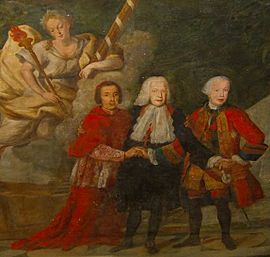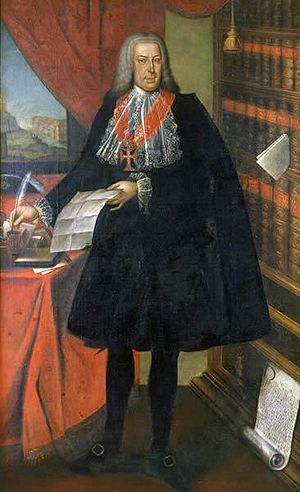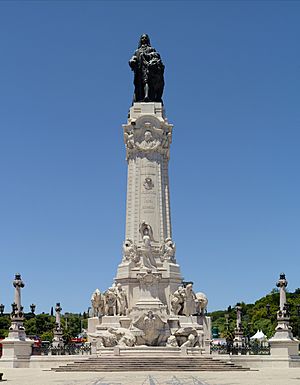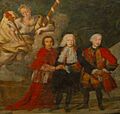Sebastião José de Carvalho e Melo, 1st Marquis of Pombal facts for kids
Quick facts for kids
The Marquis of Pombal
FC
|
|
|---|---|
 |
|
| Secretary of State of Internal Affairs of the Kingdom |
|
| In office 6 May 1756 – 4 March 1777 |
|
| Monarch | Joseph I |
| Preceded by | Pedro da Mota e Silva |
| Succeeded by | Viscount of Vila Nova de Cerveira |
| Secretary of State of Foreign Affairs and War |
|
| In office 2 August 1750 – 6 May 1756 |
|
| Monarch | Joseph I |
| Preceded by | Marco António de Azevedo Coutinho |
| Succeeded by | Luis da Cunha Manuel |
| Personal details | |
| Born | 13 May 1699 Lisbon, Portugal |
| Died | 8 May 1782 (aged 82) Pombal, Portugal |
| Spouses | Teresa de Noronha e Bourbon Mendonça e Almada Eleonora Ernestina von Daun |
| Occupation | Politician, diplomat |
| Cabinet | |
| Signature | |
Sebastião José de Carvalho e Melo (born May 13, 1699 – died May 8, 1782) was a very important Portuguese leader. He is better known as the Marquis of Pombal. From 1750 to 1777, he was the chief minister to King Joseph I. This meant he was effectively in charge of the Portuguese Empire.
Pombal was a reformer who believed in new ideas from the Age of Enlightenment. He helped Portugal recover after the terrible 1755 Lisbon earthquake. He also modernized how the country was run, its economy, and its religious organizations. During his time as a minister, Pombal became very powerful.
Contents
Meet the Marquis of Pombal
His Early Life
Sebastião José de Carvalho e Melo was born in Lisbon, Portugal. His father was a country squire, which means he owned land in the countryside. His uncle, Paulo de Carvalho, was an important church leader and a professor.
Young Sebastião studied at the University of Coimbra. He also spent a short time in the army. Later, he moved back to Lisbon. He married Teresa de Mendonça e Almada, even though her family did not approve. They moved to his family's land near Pombal. There, he continued to study law and history. He could speak Portuguese and French very well.
Starting His Political Career
Before becoming a powerful minister, Pombal had a less known career. In 1738, his uncle helped him get his first public job. He became the Portuguese ambassador to Great Britain. In 1740, he was even chosen to be a Fellow of the Royal Society. While in London, he studied how Britain became so strong in trade and naval power.
In 1745, he became the Portuguese ambassador to Austria. The Queen of Portugal, Mary Anne Josepha of Austria, liked him a lot. After his first wife passed away, the Queen helped him marry Eleonora Ernestina von Daun.
King John V was not happy about this marriage and called Pombal back to Portugal in 1749. However, King John V died the next year. His son, Joseph I of Portugal, became the new king. King Joseph I liked Pombal and made him the Minister of Foreign Affairs. As the King trusted him more, Pombal gained more control over the country.
By 1755, the King made Pombal his Prime Minister. Pombal had seen how successful England's economy was. He then brought similar economic ideas to Portugal.
Important Changes and Reforms
Pombal made many big changes in Portugal. He stopped the import of black slaves within Portugal and Portuguese India. However, he did encourage the slave trade to Brazil. He also improved the army and the navy. He ended old laws that discriminated against New Christians, who were Jewish people who had converted to Christianity. These laws had been used by the Portuguese Inquisition.
The Pombaline Reforms
The Pombaline Reforms were a set of changes designed to make Portugal strong and independent. These reforms aimed to expand Portuguese territory in Brazil. They also made the government in colonial Brazil more efficient. There were also financial and economic changes in both the colony and Portugal.
In the 1750s, Portugal was seen as a small and old-fashioned country. Its economy relied heavily on Brazil and on manufactured goods from England. Pombal wanted Portugal to produce more of its own goods. This became even more important after the 1755 Lisbon earthquake and wars with Spain.
Pombal's most important reforms were about the economy. He created new companies and groups to control all trade. For example, he created the Douro Wine Company. This company marked out the Douro wine region to control the quality of Port wine. This was one of the first times in Europe that wine quality was officially controlled. He ruled strictly, making sure everyone followed the new laws. He also changed the country's tax system. These changes made some powerful noble families dislike him.
Pombal also made big changes in education. In 1759, he expelled the Jesuits from Portugal. He then created public primary and secondary schools. He introduced training for jobs and added many new teaching positions. He also added math and science departments to the University of Coimbra. New taxes were put in place to pay for these improvements.
The Great Lisbon Earthquake
On November 1, 1755, a huge earthquake hit Lisbon. It was estimated to be a magnitude 9 earthquake. The city was destroyed by the earthquake, a tsunami, and fires. Pombal survived and immediately started rebuilding the city. He famously said: What now? We bury the dead and heal the living.
Despite the disaster, Lisbon did not suffer from diseases. Within a year, parts of the city were already rebuilt. The new downtown area of Lisbon was designed to resist future earthquakes. Architects used a new method called "caging." This involved building a wooden frame inside the buildings. This made the buildings more flexible and better able to withstand shaking. They even tested models of buildings by having soldiers march around them to simulate an earthquake! The buildings in the Pombaline Downtown of Lisbon are considered the world's first earthquake-resistant buildings.
Pombal also helped the study of seismology, which is the study of earthquakes. He created a survey that was sent to every church in Portugal. It asked questions like: Did animals act strangely before the earthquake? Did the water level in wells change? How many buildings were destroyed? The answers helped scientists understand the event better. Because he was the first to try to scientifically describe an earthquake, Pombal is seen as a pioneer in modern seismology.
The Spanish Invasion
In 1761, Spain and France formed an alliance. They wanted to stop Britain from becoming too powerful. They saw Portugal as Britain's closest friend. Spain and France told Portugal to stop trading with Britain or face war. Pombal wanted Portugal to rely less on Britain in the long run. However, he and the King refused their demands.
On May 5, 1762, Spanish troops invaded Portugal. They tried to capture Porto but were pushed back. Portugal asked Britain for help. Over 7,000 British troops were sent to Portugal. They also sent military leaders to help organize the Portuguese Army.
Portuguese and British forces won important battles. They used a "scorched earth" tactic, burning crops and supplies. This, along with guerrilla attacks, caused the Spanish and French armies to suffer many losses. They were forced to retreat back to Spain.
In the Treaty of Paris (1763), Spain had to give back some land to Portugal. Portugal also gained some Spanish territory in South America during this war. After the invasion, Pombal became more worried about Britain's growing power. Even though he admired Britain, he feared they might try to take Brazil.
His Opposition to the Jesuits
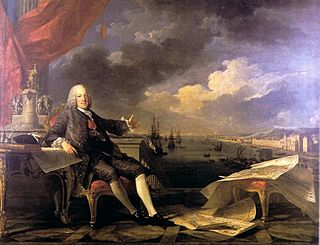
Pombal had lived in Vienna and London, which were centers of new ideas. He believed that the Society of Jesus, also known as the "Jesuits", had too much control over science and education. He thought they were holding Portugal back. He started a public campaign against them.
During the Távora affair (explained below), he accused the Jesuits of treason and trying to kill the king. This was a huge problem for the Jesuit order. Historians today note that the Jesuits often tried to protect Native Americans in the colonies. The actions against the Jesuits led to the Guarani War, which greatly reduced the population of the Guarani people.
Pombal made his brother, Paulo António de Carvalho e Mendonça, the chief inquisitor. He used the inquisition against the Jesuits. Pombal's actions helped lead to the suppression of the Jesuits across Europe. This happened in 1773 when European rulers forced the Pope to allow them to remove the order from their lands.
Expelling the Jesuits and Gaining Power
After the earthquake, King Joseph I gave Pombal even more power. Pombal became a very strong leader. As he grew more powerful, he made more enemies, especially among the high nobility.
On September 3, 1758, King Joseph I was hurt in an attempt to kill him. Pombal quickly formed a special court to investigate. Many people were found guilty, including members of the Távora family and the Duke of Aveiro. Some were sentenced to death. The Duke of Aveiro was seen as the leader of the plot. The harshness of these executions caused controversy in Europe.
There had been problems between the Portuguese crown and the Jesuits for a long time. The Távora affair became an excuse to remove the Jesuits. Their property was taken by the crown. Historians say the Jesuits' independence, wealth, control of education, and ties to Rome made them targets for Pombal. Pombal showed no mercy to anyone involved. This event finally broke the power of the old noble families.
As a reward, King Joseph I made Pombal the Count of Oeiras in 1759. In 1770, he became the Marquis of Pombal. He effectively ruled Portugal until King Joseph I died in 1777.
In 1771, a botanist named Domenico Vandelli named a genus of flowering plants, Pombalia, after the Marquis of Pombal.
His Later Years and Death
King Joseph's daughter, Queen Maria I of Portugal, did not like Pombal. She was a very religious woman and was influenced by the Jesuits. After she became queen, Maria removed Pombal from his office.
She also issued one of history's first restraining orders. It commanded that Pombal could not come closer than 20 miles to her. If she traveled near his estates, he had to leave his home to follow the royal order. It is said that even mentioning Pombal's name made the Queen very angry.
Pombal had built a palace in Oeiras. It had beautiful French gardens with Portuguese tile walls. There were also waterfalls and water features.
Pombal passed away peacefully on his estate in Pombal in 1782. He was a controversial figure during his time. Today, one of Lisbon's busiest squares and a subway station are named Marquês de Pombal in his honor. There is also a large statue of him in the square, with a lion next to him.
João Francisco de Saldanha Oliveira e Daun, 1st Duke of Saldanha was his grandson.
See also
 In Spanish: Marqués de Pombal para niños
In Spanish: Marqués de Pombal para niños
- History of Portugal
- Marquis of Pombal (title)
- List of marquises in Portugal
Images for kids


